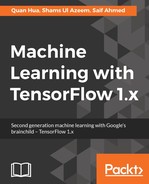Investment firms' internal proprietary trading groups use a large variety of means to invest, trade, and make money. Hedge funds, which are relatively unregulated, use an even broader, more interesting, and more sophisticated means for investment. Some investments are gut-driven or driven by a great deal of thinking. Others are largely filter-driven, algorithmic, or signal-driven. Both approaches are fine, but we'll of course focus on the latter category.
Amongst the quantitative approaches, there are numerous techniques; some of them are as follows:
- Valuation based
- Anomaly and signal based
- External signal based
- Filtering and segmentation-based cohort analysis
Some of these approaches will use traditional machine learning techniques, such as K-Nearest Neighbors, Naive Bayes, and Support Vector Machines. Cohort analysis, in particular, is almost a perfect fit for KNN-type approaches.
Another popular technique is sentiment analysis and crowd-sentiment-based signals. We covered this in the previous chapter as we gauged text sentiment and classified paragraphs of text into basic categories: positive, negative, happy, angry, and so on. Imagine if we sourced more data and filtered out everything except those involving particular stocks, we'd be able to get a valence on stocks. Now, imagine we had a source of such text that was broad (possibly global), high volume, and high velocity—actually, there is no need to imagine, as all of this entered the scene in the past decade. Twitter makes their firehose available via an API, as does Facebook, and a host of other social media platforms. Some hedge funds, in fact, consume the entire firehose of Twitter and Facebook data and attempt to extract public sentiment on stocks, market sectors, commodities, and the like. However, this is an external NLP-driven signal-based investment strategy that practitioners use to predict the directionality and/or intensity of a time series.
In this chapter, we'll use internal measures using the time series itself to predict future entries on the time series. Predicting the actual future entry is actually a very difficult task, and it turns out, not entirely necessary. Often, just a viewpoint in one direction is sufficient. A view on the direction combined with the intensity of movement is better.
For many types of investing, even the viewpoint might not give you complete assurance, rather something more right than wrong on average can be sufficient. Imagine betting a penny per flip of a coin—if you could be right 51% of the time, and if you had the ability to play the game thousands of times, it may be enough to be profitable, as you would gain more than you lose.
This all bodes well for machine learning based efforts where we may not have 100% confidence in our answers but may have good predictive ability statistically. Net-net we want to be ahead because even a slight leg-up can be multiplied by thousands of cycles to produce substantial profits.
